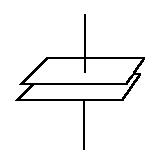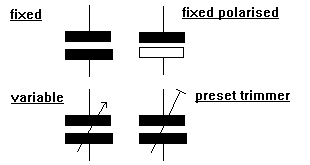

|
This insulator is called the dielectric. Capacitor types are named after the dielectric. Thus we have ceramic, mica, polyester, paper air capacitors etc. Capacitors can be charged
up and store electricity, similar to a car battery.
DC current cannot flow through a capacitor since the dielectric forms an open circuit. Capacitors come in all shapes
and sizes and are usually marked with their value.
|

| They are often marked with
their maximum working voltage. The voltage across the terminals must not
exceed this value. It is OK to use a voltage below the maximum value.
Some capacitors such as electrolytic and tantalums are polarised. This means that they must be fitted the correct way round. They are marked to indicate polarity. Some values are indicated
with a colour code similar to resistors. There can be some confusion.
|

| Some values are marked in
picofarads using three digit numbers. The first two digits are the base
number and the third digit is a multiplier.
For example, 102 is 1000 pF and 104 is 100,000 pF = 100 nF = 0.1 uF. To find the total value of
capacitors in parallel (that is connected across each other) their values
are added.
1/C total =1/C1 + 1/C2 +
1/C3 etc
Variable capacitors are available in which the value can be adjusted by controlling the amount of overlap of the plates or the distance between them. There is a type of diode called the Varicap diode which similar characteristics. |
